Introduction
In the development of blockchain technology, the trilemma of scalability, decentralization, and security has always been a key bottleneck restricting industry growth. Kaspa, through its innovative BlockDAG technology architecture, provides a new approach to solving this problem. Since the launch of its mainnet in 2021, Kaspa has seen its position in the blockchain industry continue to rise, thanks to strong technological innovation and active community support.
As of now, the total supply is 2.5 billion KAS, with a market value of approximately $2.72 billion, demonstrating strong development momentum.
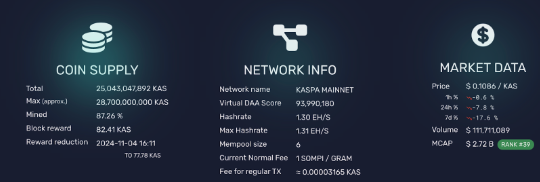
1. Technical Breakthrough: Redefining Blockchain Architecture
From Traditional Blockchain to BlockDAG: A Leap in Architectural Innovation
Unlike the single-chain structure adopted by traditional blockchains such as Bitcoin and Ethereum, Kaspa is built on the GHOSTDAG protocol, creating an innovative directed acyclic graph (DAG) structure. This architectural design allows Kaspa to achieve parallel block processing, fundamentally breaking through the performance bottlenecks of traditional blockchains.
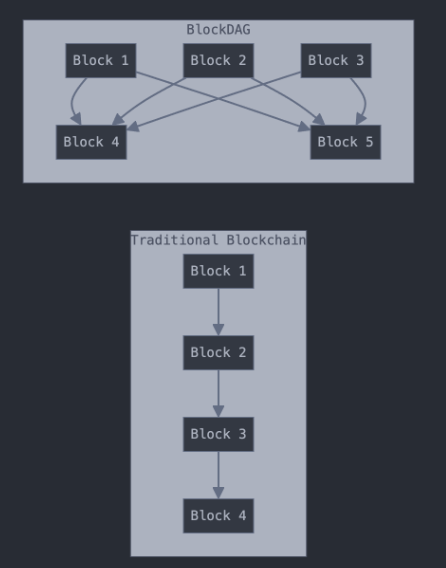
Currently, the Kaspa network has achieved a stable processing capacity of one block per second, while Bitcoin and Ethereum's block times remain at around 10 minutes and 12 seconds, respectively.
In terms of storage efficiency, Kaspa employs innovative pruning technology, retaining only about three days of transaction history. This design ensures the accessibility of critical data while significantly reducing node operation and maintenance costs. In contrast, running a full Bitcoin node requires storing over 500GB of historical data, which places significant pressure on network decentralization.
GHOSTDAG and DAGKnight: Dual Innovations in Consensus Mechanism
Kaspa's GHOSTDAG protocol originates from the PHANTOM mechanism but achieves significant breakthroughs in performance and security. Through the KHeavyHash proof-of-work algorithm, GHOSTDAG enhances energy efficiency by about 30% while maintaining the traditional PoW security. More importantly, it supports the parallel confirmation of multiple blocks, demonstrating clear advantages in high-concurrency scenarios.

On this basis, the DAGKnight protocol developed by the Kaspa team further optimizes network performance. This protocol does not require preset network delay parameters and can adapt to changes in network conditions. Actual tests show that under good network conditions, transaction confirmation times can be as low as 1.2 seconds, and even during network congestion, it can remain within an acceptable range of under 12 seconds. This flexibility is difficult for traditional blockchains like Bitcoin and Ethereum to achieve.
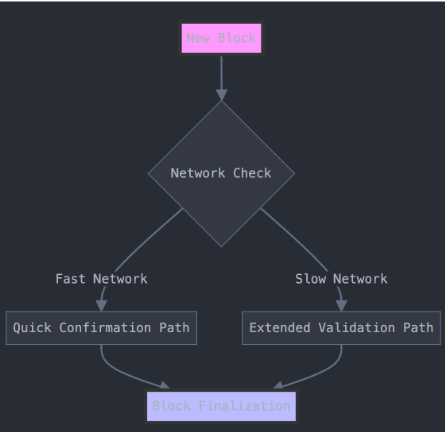
Technology Stack Upgrade: Transformation from GoLang to Rust
In early 2024, Kaspa completed the migration of its core code from GoLang to Rust, bringing significant improvements to the network. Test data shows that the Rust version improves transaction processing speed by 40% compared to the GoLang version, with memory usage efficiency increasing by 35%. Currently, 96.49% of nodes have completed the migration, and the network's operational stability has significantly improved.
In comparison, other mainstream blockchain projects still primarily use traditional languages such as Go and C++. The adoption of Rust not only enhances performance but also provides additional security guarantees through its strict memory safety mechanisms. This technical choice demonstrates the Kaspa team's foresight in performance and security.
Performance Comparison: Data Speaks
In key performance indicators, Kaspa shows clear advantages:
- Transaction Processing Capacity (TPS):
Kaspa: Theoretical limit can reach thousands of TPS, currently stable at 40-50 TPS
Bitcoin: 3-7 TPS
Ethereum: 15-20 TPS
- Transaction Confirmation Time:
Kaspa: Fastest 1.2 seconds, generally not exceeding 12 seconds
Bitcoin: Average 60 minutes (6 block confirmations)
Ethereum: Average 3-5 minutes (12 block confirmations)
- Network Energy Efficiency:
Kaspa: Energy consumption per transaction is about 65% lower than Bitcoin
Bitcoin: Approximately 700 kilowatt-hours per transaction
Ethereum: Although it has transitioned to PoS, its level of decentralization is questioned
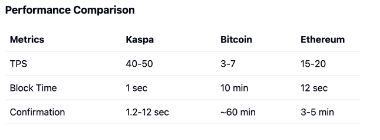
2. Industrial Applications: Breakthroughs from Theory to Practice
Practical Verification by Mining Giants
The case of Marathon Digital vividly demonstrates Kaspa's potential in industrial applications. Since starting its Kaspa mining operations in September 2023, Marathon has successfully mined 93 million KAS, valued at approximately $15 million (as of June 25, 2024). The company has purchased about 60 PH of KS3, KS5, and KS5 Pro ASIC miners, achieving profit margins as high as 95% in certain cases. This success has prompted Marathon to further expand its investment, with plans for full operations expected in the third quarter of 2024.
Notably, even occupying only 1% of Marathon's 1100 megawatt data center portfolio, Kaspa's mining operations have demonstrated significant profitability. This efficient resource utilization proves Kaspa's technological competitive advantage in industrial applications.
Innovative Applications in the Energy Sector
In the energy sector, Kaspa's application scenarios are moving from theory to practice. Through collaboration with the Desert Energy Initiative (Dii), Kaspa is exploring new models for renewable energy trading.
Specific applications include:
Green Energy Trading
Supporting cross-border renewable energy certificate trading
Providing real-time energy measurement and settlement
Ensuring transparency and traceability of transactions
Carbon Emission Rights Market
- With the carbon emission rights market expected to reach $20 trillion by 2030, Kaspa's high-performance characteristics will play an important role. The system can handle thousands of transactions simultaneously, meeting the market's demand for high-frequency trading.
Breakthrough Applications of the KRC-20 Protocol
The important infrastructure of the Kaspa ecosystem, Kasplex, has been launched on the mainnet. The supported KRC-20 protocol successfully processed 90 million transactions during a three-month internal testing and stress testing phase.
This achievement fully validates the performance advantages of the Kaspa network:
Fast transaction speed
Low transaction fees
Strong network stability
3. Technical Ecosystem: "Dual-Engine Drive" Strategy
Infrastructure Development
Kaspa adopts a "dual-engine drive" strategy to promote ecosystem development.
On one hand, it provides complete infrastructure support through Kasplex:
Data insertion protocol
Open-source indexer
Powerful API system
Standardized token protocol
On the other hand, the KEF Katalyst Program Season 1 invests $10 million to support ecosystem construction, covering:
Developer support
Innovative project incubation
Education and training programs
Technical Community Building
An active developer community is a significant advantage for Kaspa. Currently:
Over 200 active contributors on GitHub
An average of over 100 code submissions merged monthly
Regular technical seminars and hackathons
4. A New Chapter in the Development of the Kaspa Ecosystem
KEF Katalyst Program: A Milestone in Ecosystem Development
In September 2024, the Kaspa Ecosystem Foundation launched the KEF Katalyst Program with a total amount of $10 million, a strategic ecosystem development plan implemented in four phases:
- Sowing Phase
Synchronizing with the Token2049 Singapore event
Enhancing Kaspa's visibility through diverse activities
Incentivizing early projects to participate in ecosystem construction
- Germination Phase
Planned to launch in November to coincide with Kaspa's third anniversary
Introducing a systematic education program
Helping new users and developers gain a deeper understanding of Kaspa technology
- Growth Phase
Coordinating with the launch of smart contracts
Hosting large-scale hackathon events
Incubating innovative projects
- Fruiting Phase
Project showcase day events
Ecosystem project competitions
Promoting collaborative development among projects
Multi-Dimensional Support for Ecosystem Construction
The KEF Katalyst Program provides comprehensive ecosystem support:
- Financial Support
Project development funding
Innovative reward mechanisms
Long-term development funds
- Infrastructure Development
Developer toolchain
Technical documentation system
Testnet environment
- Educational Empowerment
Developer Training
Technical Seminars
User Education Content
- Community Building
Online and Offline Activities
Project Roadshows
Community Interaction Platforms
Early Ecosystem Project Showcase
Early projects like KANGO Token have demonstrated the development potential of the Kaspa ecosystem:
Number of Holders: 1,703 addresses
Transaction Activity: 21,161 transfers
Daily Transaction Volume: Approximately $1.94M
Market Capitalization: Approximately $7.42M
Supported by multiple trading platforms
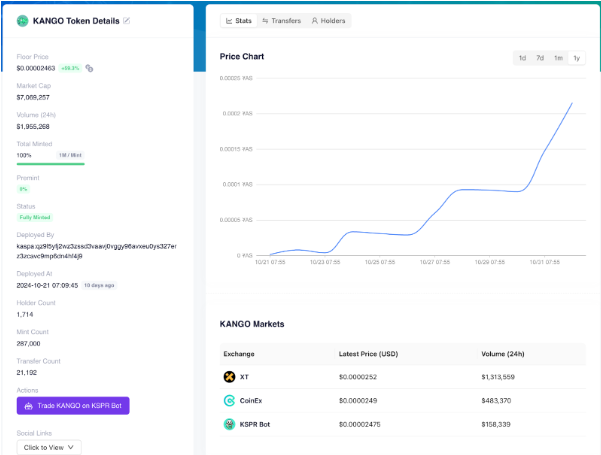
Infrastructure projects, including KSPR Bot, are also rapidly developing, providing necessary tools and liquidity support for the ecosystem.
Ecosystem Development Vision
The launch of the KEF Katalyst Program marks a new phase in Kaspa's ecosystem construction. Through a clear development path of "Sowing - Germination - Growth - Fruiting," combined with comprehensive support measures, Kaspa is building a sustainable blockchain ecosystem. With the upcoming launch of smart contracts and ongoing community building and project incubation, we have reason to expect greater development for the Kaspa ecosystem in the future.
5. Future Outlook and Challenges
Kaspa's development still faces some challenges:
- Technical Aspects
Continuous optimization of network performance
Ensuring a balance between security and decentralization
Improving the developer toolchain
- Market Aspects
Strengthening market education
Expanding more application scenarios
Establishing industry standards
However, from the current development trend, Kaspa shows strong development potential:
Continuous breakthroughs in technological innovation
Gradual implementation of industrial applications
Increasingly完善的 ecosystem
6. Conclusion
As a representative of the new generation of blockchain technology, Kaspa has successfully achieved technological breakthroughs through its innovative BlockDAG architecture. Its balanced development in performance, security, and decentralization opens up new possibilities for the industrial application of blockchain technology. With the continuous evolution of technology and the ongoing expansion of application scenarios, we have reason to believe that Kaspa will play an increasingly important role in promoting the integration of blockchain technology with traditional industries. In the digital economy era, Kaspa is writing a new chapter in the development of blockchain technology.
About Us
Hotcoin Research, as the core investment research department of Hotcoin, is dedicated to providing detailed and professional analysis for the cryptocurrency market. Our goal is to offer clear market insights and practical operational guidelines for investors at different levels. Our professional content includes the "Play and Earn Web3" tutorial series, in-depth analysis of cryptocurrency industry trends, detailed analyses of potential projects, and real-time market observations. Whether you are a newcomer exploring the crypto space for the first time or a seasoned investor seeking deeper insights, Hotcoin will be your reliable partner in understanding and seizing market opportunities.
Risk Warning
The cryptocurrency market is highly volatile, and investment carries risks. We strongly recommend that investors conduct investments based on a full understanding of these risks and within a strict risk management framework to ensure the safety of their funds.
Website: https://www.hotcoin.com/
Medium: medium.com/@hotcoinglobalofficial
免责声明:本文章仅代表作者个人观点,不代表本平台的立场和观点。本文章仅供信息分享,不构成对任何人的任何投资建议。用户与作者之间的任何争议,与本平台无关。如网页中刊载的文章或图片涉及侵权,请提供相关的权利证明和身份证明发送邮件到support@aicoin.com,本平台相关工作人员将会进行核查。



